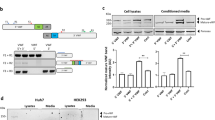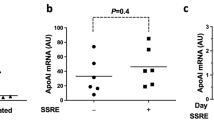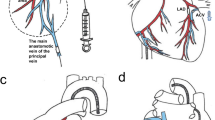Abstract
Increasing the level and duration of transgene expression and restricting expression to vascular cells are important goals for clinically useful gene therapy vectors. We evaluated several promoters, enhancers and introns in endothelial, smooth muscle and liver cells in tissue culture and in vivo, comparing local delivery to the carotid artery with intravenous delivery to the liver. A 1800-bp fragment of the oxidized LDL receptor (LOX-1) promoter showed highest in vivo activity in the carotid artery, achieving 39% the activity of the reference cytomegalovirus promoter, with 188-fold greater specificity for carotid artery over liver. An enhancer from the Tie2 gene in combination with the intracellular adhesion molecule-2 promoter improved endothelial specificity of plasmid vectors, increased the expression from adenoviral vectors in cultured endothelial cells and doubled the specificity for carotid artery over liver in vivo. Adding a short intron to expression cassettes increased expression in both endothelial and smooth muscle cells in vitro; however, the eNOS enhancer failed to consistently increase the expression or endothelial specificity of the vector. In conclusion, elements from the LOX-1 promoter and Tie2 enhancer together with an intron can be used to improve vectors for vascular gene transfer.
This is a preview of subscription content, access via your institution
Access options
Subscribe to this journal
Receive 12 print issues and online access
$259.00 per year
only $21.58 per issue
Buy this article
- Purchase on Springer Link
- Instant access to full article PDF
Prices may be subject to local taxes which are calculated during checkout




Similar content being viewed by others

References
Landmesser U, Hornig B, Drexler H . Endothelial function—a critical determinant in atherosclerosis? Circulation 2004; 109: 27–33.
White SJ, Newby AC . Gene therapy for all aspects of vein-graft disease. J Card Surg 2002; 17: 549–555.
Brewster LP, Brey EM, Greisler HP . Cardiovascular gene delivery: the good road is awaiting. Adv Drug Deliv Rev 2006; 58: 604–629.
Jazwa A, Jozkowicz A, Dulak J . New vectors and strategies for cardiovascular gene therapy. Curr Gene Ther 2007; 7: 7–23.
Higuchi Y, Hirayama A, Shimizu M, Sakakibara T, Kodama K . Postoperative changes in angiographically normal saphenous vein coronary bypass grafts using intravascular ultrasound. Heart Vessels 2002; 17: 57–60.
Kimura T, Kaburagi S, Tamura T, Yokoi H, Nakagawa Y, Yokoi H et al. Remodeling of human coronary arteries undergoing coronary angioplasty or atherectomy. Circulation 1997; 96: 475–483.
De Geest B, Van Linthout S, Lox M, Collen D, Holvoet P . Sustained expression of human apolipoprotein A-I after adenoviral gene transfer in C57BL/6 mice: role of apolipoprotein A-I promoter, apolipoprotein A-I introns, and human apolipoprotein E enhancer. Hum Gene Ther 2000; 11: 101–112.
Morishita K, Johnson DE, Williams LT . A novel promoter for vascular endothelial growth factor receptor (flt-1) that confers endothelial-specific gene expression. J Biol Chem 1995; 270: 27948–27953.
Cowan PJ, Shinkel TA, Witwort EJ, Barlow H, Pearse MJ, D'Apice AJF . Targeting gene expression to endothelial cells in transgenic mice using the human intercellular adhesion molecule 2 promoter. Transplantation 1996; 62: 155–160.
Hegen A, Koidl S, Weindel K, Marme D, Augustin HG, Fiedler U . Expression of angiopoietin-2 in endothelial cells is controlled by positive and negative regulatory promoter elements. Arterioscler Thromb Vasc Biol 2004; 24: 1803–1809.
Karantzoulis-Fegaras F, Antoniou H, Lai SLM, Kulkarni G, D'Abreo C, Wong GKT et al. Characterization of the human endothelial nitric-oxide synthase promoter. J Biol Chem 1999; 274: 3076–3093.
Neish AS, Williams AJ, Palmer HJ, Whitley MZ, Collins T . Functional analysis of the human vascular adhesion molecule 1 promoter. J Exp Med 1992; 176: 1583–1593.
Jahroudi N, Lynch DC . Endothelial-cell-specific regulation of von Willebrand factor gene expression. Mol Cell Biol 1994; 14: 999–1008.
Korhonen J, Lahtinen I, Halmekyto M, Alhonen L, Janne J, Dumont D et al. Endothelial-specific gene expression directed by the tie gene promoter in vivo. Blood 1995; 86: 1828–1835.
Patterson C, Perrella MA, Hsieh C-M, Yoshizumi M, Lee M-E, Haber E . Cloning and functional analysis of the promoter for KDR/flk-1, a receptor for vascular endothelial growth factor. J Biol Chem 1995; 270: 23111–23118.
Minami T, Kuivenhoven JA, Evans V, Kodama T, Rosenberg RD, Aird WC . Ets motifs are necessary for endothelial cell-specific expression of a 723-bp Tie-2 promoter/enhancer in Hprt targeted transgenic mice. Arterioscler Thromb Vasc Biol 2003; 23: 2041–2047.
Aoyama T, Sawamura T, Furutani Y, Matsuoka R, Yoshida MC, Fujiwara H et al. Structure and chromosomal assignment of the human lectin-like oxidized low-density-lipoprotein receptor-1 (LOX-1) gene. Biochem J 1999; 339: 177–184.
Yamanaka S, Zhang XY, Miura K, Kim S, Iwao H . The human gene encoding the lectin-type oxidized LDL receptor (OLR1) is a novel member of the natural killer gene complex with a unique expression profile. Genomics 1998; 54: 191–199.
Hou JZ, Baichwal V, Cao ZD . Regulatory elements and transcription factors controlling basal and cytokine-induced expression of the gene encoding intercellular-adhesion molecule-1. Proc Natl Acad Sci USA 1994; 91: 11641–11645.
Tessitore A, Pastore L, Rispoli A, Cilenti L, Toniato E, Flati V et al. Two gamma-interferon-activation sites (GAS) on the promoter of the human intercellular adhesion molecule (ICAM-1) gene are required for induction of transcription by IFN-gamma. Eur J Biochem 1998; 258: 968–975.
Laumonnier Y, Nadaud S, Agrapart M, Soubrier F . Characterization of an upstream enhancer region in the promoter of the human endothelial nitric-oxide synthase gene. J Biol Chem 2000; 275: 40732–40741.
Schlaeger TM, Bartunkova S, Lawitts JA, Teichmann G, Risau W, Deutsch U et al. Uniform vascular-endothelial-cell-specific gene expression in both embryonic and adult transgenic mice. Proc Natl Acad Sci USA 1997; 94: 3058–3063.
Antoniou M, Geraghty F, Hurst J, Grosveld F . Efficient 3′-end formation of human beta-globin mRNA in vivo requires sequences within the last intron but occurs independently of the splicing reaction. Nucl Acids Res 1998; 26: 721–729.
Nicklin SA, Reynolds PN, Brosnan MJ, White SJ, Curiel DT, Dominiczak AF et al. Analysis of cell-specific promoters for viral gene therapy targeted at the vascular endothelium. Hypertension 2001; 38: 65–70.
Chen J, Liu Y, Liu H, Hermonat PL, Mehta JL . Molecular dissection of angiotensin II-activated human LOX-1 promoter. Arterioscler Thromb Vasc Biol 2006; 26: 1163–1168.
Yamamoto M, Davydova J, Takayama K, Alemany R, Curiel DT . Transcription initiation activity of adenovirus left-end sequence in adenovirus vectors with E1 deleted. J Virol 2003; 77: 1633–1637.
Papadakis ED, Nicklin SA, Baker AH, White SJ . Promoters and control elements: designing expression cassettes for gene therapy. Curr Gene Ther 2004; 4: 89–113.
Pajusola K, Gruchala M, Joch H, Luscher TF, Yla-Herttuala S, Bueler H . Cell-type-specific characteristics modulate the transduction efficiency of adeno-associated virus type 2 and restrain infection of endothelial cells. J Virol 2002; 76: 11530–11540.
Hegenbarth S, Gerolami R, Protzer U, Tran PL, Brechot C, Gerken G et al. Liver sinusoidal endothelial cells are not permissive for adenovirus type 5. Hum Gene Ther 2000; 11: 481–486.
Ehrhardt A, Peng PD, Xu H, Meuse L, Kay MA . Optimization of cis-acting elements for gene expression from nonviral vectors in vivo. Hum Gene Ther 2003; 14: 215–225.
McGrory WJ, Bautista DS, Graham FL . A simple technique for the rescue of early region I mutations into infectious human adenovirus type 5. Virology 1988; 163: 614–617.
von der Thusen JH, Kuiper J, Fekkes ML, de Vos P, van Berkel TJC, Biessen EAL . Attenuation of atherogenesis by systemic and local adenovirus-mediated gene transfer of interleukin-10 in LDLr−/− mice. FASEB J 2001; 15: U19–U37.
Wilkinson GWG, Akrigg A . Constitutive and enhanced expression from the CMV major IE promoter in a defective adenovirus vector. Nucleic Acids Res 1992; 20: 2233–2239.
Geddes BJ, Harding TC, Lightman SL, Uney JB . Long-term gene therapy in the CNS: reversal of hypothalamic diabetes insipidus in the Brattleboro rat by using an adenovirus expressing arginine vasopressin. Nat Med 1997; 3: 1402–1404.
Acknowledgements
We thank Ray Bush (University of Bristol) for help with animal work; Jill Tarlton and Melanie Roberts (University of Bristol) for help with virus production and technical assistance; James Uney (University of Bristol) for plasmid pXCX-CMV;34 Mike Antoniou (Kings College, London) for the provision of Cβ88 plasmid, containing the Δ89 truncated β-globin 2nd intron23 (intron B); Alessandra Tessitore (University of L'Aquila) for plasmid LC120 containing full ICAM-1 promoter; Anja Ehrhardt (Stanford University) for plasmid pHM5/hFIX.30 This work was performed at the Bristol Heart Institute, the University of Bristol. SJW was supported by British Heart Foundation intermediate fellowship (FS/03/096/16318).
Author information
Authors and Affiliations
Corresponding author
Additional information
Conflict of interest
The authors have no conflicts of interest to declare.
Supplementary information accompanies the paper on Gene Therapy website (http://www.nature.com/gt)
Rights and permissions
About this article
Cite this article
White, S., Papadakis, E., Rogers, C. et al. In vitro and in vivo analysis of expression cassettes designed for vascular gene transfer. Gene Ther 15, 340–346 (2008). https://doi.org/10.1038/sj.gt.3303058
Received:
Revised:
Accepted:
Published:
Issue Date:
DOI: https://doi.org/10.1038/sj.gt.3303058


